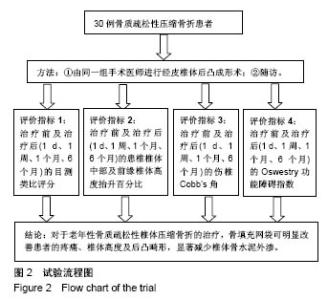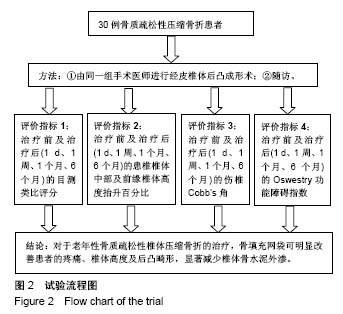| [1] 胥少汀.实用骨科学[M].3版.北京:人民军医出版社,2005:1198.[2] Galibert P,Deramond H,Roast P,et al.Preliminary note on the treatment of vertebral angioma by percutaneous acrylic vertebroplasty. Neurochirurgie.1987;33(2):166-168.[3] Rllinghoff M,Siewe J,Zarghooni K,et al. Effectiveness, security and height res toration on fresh compression fractures acomparetive prospective study of vertebroplasty and kyphoplasty.Minim Invasive Neurosurg. 2009;52(5-6)233-237.[4] 孙钢,金鹏,刘训伟,等.球囊扩张椎体后凸成形术的技术操作及相关问题的探讨[J].中华放射学杂志,2007, 41(11):1224.[5] 吴春根,程永德.加强脊柱介入放射学的技术研究和临床应用[J].介入放射学杂志,2008,17(2):417-420.[6] 刘仲宇.骨质疏松椎体压缩骨折的微创治疗进展[J].中国修复重建外科杂志,2014,28(4):522-526.[7] 陈惠国,陈锦平,梁海萍,等.骨水泥注射剂量对胸腰段椎体后凸成形术后并发骨折的回顾性研究[J].中国骨伤, 2012,25(8):681-683.[8] Dalton BE,Kohm AC,Miller LE,et al.Radiofrequency targeted vertebral augmentation versus traditional balloon kyphoplasty: radiographic and Morphologic outcomes of an ex vivo biomechanical pilot study.Clin Interv Aging. 2012;7(12):525-531.[9] 孟飞,曾文魁,王愉思,等.PKP与PVP治疗骨质疏松性胸腰椎压缩骨折的比较分析[J].军医进修学院学报,2012,33(1):56-58.[10] 丁慧宇,夏建龙.PVP、PKP治疗胸腰椎骨质疏松性椎体压缩骨折的疗效评价标准研究性进展[J].山东医药, 2014,54(14):101-103.[11] 陈学谦,赵继阳,陈郑增,等.PVP术与PKP术治疗骨质疏松性胸腰椎压缩骨折效果比较[J].现代中西医结合杂志, 2014,23(10):1064-1066.[12] 雷洪俊.PKP和PVP治疗骨质疏松性胸腰椎压缩性骨折缓解疼痛的临床疗效观察[J].中国伤残医学,2013,21(4):86.[13] Phillips FM.Minimally invasive treatments of osteoporotic vertebral compression fractures.Spine (Phila Pa 1976). 2003;28(1):45-53.[14] 王亦地.骨与关节损伤[M].北京:人民卫生出版社, 2007:1066-1070.[15] Yapici F,Atici Y,Balioglu MB,et al.A comparison of two techniques;open and percutaneous biopsies of thoracolumbar vertebral body lesions.J Craniovertebr Junction Spine. 2015;6(1):36-39.[16] 崔冠宇,田伟,刘波,等.PKP与椎体强化后椎弓根钉内固定治疗骨质疏松性胸腰椎爆裂骨折的临床比较研究[J].中国骨与关节损伤杂志, 2015,30(7): 690-693.[17] Max A,JohnST,John KW,等.AOAS正脊柱内固定[M].党耕盯,刘忠军,陈仲强,主译.北京:人民卫生出版社,2000:80-100.[18] 王树金,孔丹辉,吴树华,等.经皮椎体成形术治疗胸腰椎骨质疏松性椎体压缩骨折疗效分析.中华临床医师杂志(电子版), 2014,8(18):170-172.[19] 王冰,朱裕成,马军,等.经皮后凸成形术在治疗多节段骨质疏松性椎体压缩性骨折的应用[J].临床骨科杂志,2012,17(11):17-20.[20] 王兴武,陈建猛,俞武良,等.经皮椎体成形术与后凸成形术治疗急性骨质疏松性轻度压缩骨折的疗效及成本比较[J].临床骨科杂志, 2012,15(2): 125-128.[21] Zhou JH,Liu SQ,Ming JH,et al.Comparison of therapeutic effect between percutaneous vertebroplasty and kyphoplasty on vertebral compression fracture.Chin J Traumatol. 2008;11(1):142-144.[22] Baumann C,Fuchs H,Kiwit J,et al.Complication in percutaneous vertebroplasty associated with puncture or cement leakage. Cardiovasc Intervent Radiol. 2007;30(2):161-168.[23] Kumar K,Nguyen R,Bishop S.A comparative analysis of the results of vertebroplasty and kyphoplasty in osteoporotic vertebral compression fractures.Neurosurgery. 2010;67(S3):171-188.[24] Liebschner MA,Rosenberg WS,Keaveny TM.Effects of bone cement volume and distribution on vertebral stiffness after vertebroplaty. Spine (Phila Pa 1976).2001;26(14):1547-1554.[25] 张子玉,曹立新,范桂红,等.PKP不同剂量骨水泥注入治疗骨质疏松性椎体压缩骨折首发病例的疗效[J].中国老年学杂志, 2015;35(10):2757-2758.[26] 张鹭,吴军,路锟,等.经皮椎体成形术治疗老年骨质疏松椎体压缩骨折术后临近椎体骨折的相关危险因素[J].中国老年学杂志, 2015;35(16): 4612-4614.[27] 郑毓嵩,张勇,林金丁,等.椎体成形术骨水泥渗漏的相关危险因素分析[J].中华创伤杂志,2015,31(4):312-316.[28] 吴强,莫世赞,包拥政,等.椎体成形治疗后骨水泥在椎体内弥散的影响因素[J].中国组织工程研究,2014,18(43):6922-6928.[29] 梁德,叶林强,江晓兵,等.骨水泥-椎体体积比及椎体骨壁裂口与经皮椎体成形术骨水泥渗漏的相关性分析[J].中国修复重建外科杂志,2014,28(11): 1358-1363.[30] Rotter R,Martini H,Fyerderer S,et al.Vertebral body stenting:a new method for vertebral augmentation versus kyphoplasty.Eur Spine J. 2010;19(6):916-923.[31] Tzermiadianos MN,Renner SM,Philips FM,et al.Aletred disc pressure profile after an osteo-porotic vertebral fracture is a risk factor for adjacent vertebral body fracture.Eur Spine. 2008;17(11):1522-1530.[32] Adams MA,Pollintine P,Tobias JH,et al.Intervertebral disc degeneration can predipose to anterior vertebral fractures in the thoracolumbar spine.J Bone Miner Res. 2006;21(9):1409-1416.[33] Darwono AB,Vesseplasty:a novel concept of percutaneous teratment for stabilization and height restoration of vertebral compression fractures. J Mus Res.2007;11(2):71-79.[34] 李东华,刘训伟,彭湘涛,等.骨填充网袋灌注骨水泥修复椎体压缩骨折:可降低骨水泥椎体外渗漏率[J].中国组织工程研究, 2015,19(3):358-363. |





